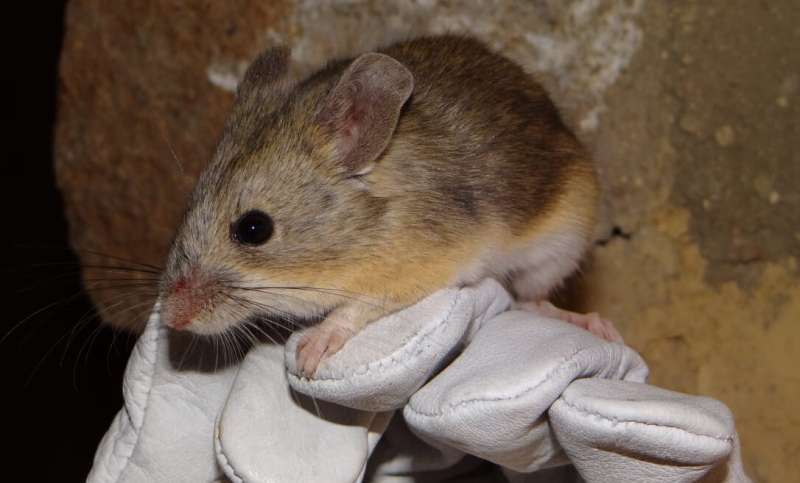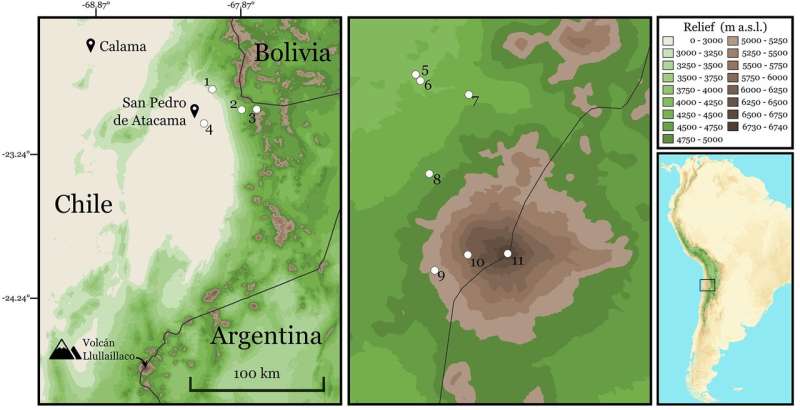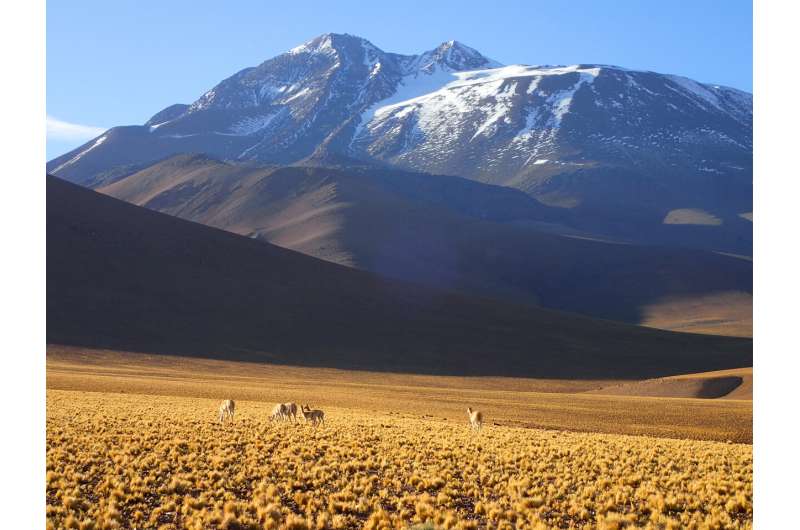Biologist discovers world's highest-elevation mammal

They had climbed for eight hours—Had it really been just eight? Nine, maybe? More?—after the avalanche risk of a snow-packed ravine on the main path had forced them onto a more circuitous, arduous route.
Up here, the summer weather of February felt uncomfortably similar to a Nebraska winter.
"Jay, hay un ratón!" ("Jay, there's a mouse!")
Jay Storz couldn't breathe. Couldn't think. Couldn't respond.
"Un ratón, Jay!"
Disoriented and fatigued after a sleepless night spent huddled in a tent, his lungs scrounging for oxygen amid the frigid air, Storz willed himself to semi-awareness.
"No lo veo (I don't see it)," the biologist managed.
"Está debajo de esa piedra." ("It's under that rock.")
World-class mountaineer Mario Pérez Mamani had guided the pair to the summit of Llullaillaco (zhoo-zhuh-ZHEYE'-koh), a dormant volcano on the western edge of the Andes Mountains and the southern fringe of the Atacama Desert.
There, more than 22,000 feet above the sea-level border separating Chile and Argentina, an alert Pérez Mamani had indeed spotted a mouse.
But not just any mouse. This mouse—a yellow-rumped leaf-eared mouse, Phyllotis xanthopygus rupestris—was a special mouse. A miraculous mouse. A world-record mouse.
No mammal had ever been reported living at such extreme elevation. Storz, finally coming to and armed with reflexes honed by a childhood of catching lizards, clambered over to the rock and knelt. Wrapping his right hand around its far edge, he flipped the rock backward. Startled, the mouse scurried beneath another.
For a few long seconds, the mouse darted and feinted under the cover of its sanctuary, uncertain. Then: a dash. Storz pounced. He had it.
With that, Storz and Pérez Mamani had captured unprecedented evidence of the ultimate mammalian survivor: a rodent living on just 45% of sea-level oxygen and an unknown diet while enduring temperatures that can plummet to minus 75 degrees Fahrenheit.
"This discovery makes me think that we've probably underestimated the elevational range limits and physiological tolerances of mammals and other vertebrates, simply because the world's highest summits are relatively unexplored by biologists," said Storz, Willa Cather Professor of biological sciences at the University of Nebraska–Lincoln. "It's hard to overstate the hostility of the environment that these mice call home."
The discovery culminated a month-long research expedition that was inspired by a stunning video clip from a 2013 mountaineering expedition on Llullaillaco. Recorded by climber Matt Farson, the clip showed a mouse scampering across an expanse of snow at roughly 20,000 feet—far higher than any previously reported mammal at the time.
"No one expected mammals to be able to survive and function at such an extreme altitude," Storz said. "The conventional wisdom was always that the elevational range limits of mammals were something close to 17,000 feet, and above that was (considered) basically barren of terrestrial vertebrate life."
Mountaineer and mouseketeers
With funding from the National Geographic Society, Storz eventually teamed up with Pérez Mamani and a few fellow biologists, including Guillermo D'Elía and Marcial Quiroga-Carmona of Universidad Austral de Chile, to launch an expedition of their own.
In February, the team spent two weeks ascending the flanks of Llullaillaco while trapping mice at altitudes of up to 15,000 feet, kept company all the while by pumas, foxes, two camel species and other hardy denizens of the Andes.
The group then established a base camp at 16,500 feet and another at 19,500 feet, where they set Sherman traps—hinged metal boxes designed to capture live specimens—for another week. By the time Storz and Pérez Mamani were ready to head for Llullaillaco's summit, the team had already caught record-elevation specimens of three mouse species: the altiplano laucha, the Andean altiplano and the Lima leaf-eared.

When they sensed the weather stabilizing, Pérez Mamani and Storz made the four-hour ascent from base camp to the tent they had stashed at 19,500 feet. Though its canvas shielded the duo from the elements, it couldn't offer a good night's sleep.
"You can't really sleep at that elevation, just because the lack of oxygen makes it impossible," Storz said. "Basically, you're just staying warm and resting."
They set out for the summit at 3 a.m., intent on beating the afternoon storms that frequently strike at extreme elevation. With decades of experience on the Andean slopes, Pérez Mamani led the way and reached the peak first.
"By the time I finally arrived at the summit, I was completely exhausted," Storz said. "And at that elevation, doing anything is pretty exhausting."
But fatigue wasn't the sole reason that Storz struggled to process what Pérez Mamani was telling him on the summit, which ranks as the second-highest of any active volcano. Sheer surprise played a role, too.
"That particular day … was not a day that we had devoted to research activities," Storz said of the world-record capture, the only one made by hand during the expedition. "So it was a completely unexpected, kind of fortuitous discovery."
'There's a lot left to do'
Discovering the yellow-rumped leaf-eared mouse at 22,000 feet has naturally left Storz and his colleagues with plenty of questions. Considering that the team found the species living more than a mile above even the hardiest green plants, one question rises above most others: What exactly does it eat up there? Though insects and the fungi-algae mishmashes known as lichens seem like reasonable candidates, the biologists expect to gain clearer insights after examining the mouse's stomach contents and gut bacteria.
The team is also keen to better understand the species' sea-to-sky versatility.

"One of the really remarkable things about this particular species … is that not only does it occur at these really extreme altitudes, but members of the same species are also found all the way to sea level," Storz said. "So it has this extremely broad elevational distribution. (That) raises a lot of really important evolutionary questions."
Having spent years researching how genetic mutations contribute to more efficient hemoglobin—the blood protein that transports oxygen from lungs to cells—Storz will be hunting for differences between the mice living at oxygen-rich sea level versus oxygen-poor altitudes.
"We're going to be doing a lot of experiments to figure out what specialized physiological adaptations they've evolved to these low-oxygen conditions," he said. "And we're analyzing whole-genome sequences to figure out the genetic changes involved. So there's a lot left to do."
And, he said, future summits to be made.
"There's definitely the potential for more expeditions to figure out how common this is and to discover more about the physiological limits of animal life at high altitude."
Provided by University of Nebraska-Lincoln




















